Nov 302014
Another collector asked me for pictures of the cards in my Tandy Model 6000’s card cage in order to help identify all of them. So, here they are!
I took pictures of both sides of all cards but one (the second serial port card, on which I forgot to take a picture of the solder side). Click each picture for a larger version with a more detailed description. I’ll update the descriptions as I learn more details about each card.
- Card Cage with Cards Installed
- Card Cage with Cards Removed
- Motherboard and Cables
- Peeking Under the Cables
- Card 1: 68000 CPU (Top)
- Card 1: 68000 CPU (Bottom)
- Card 2: 68000 RAM (Top)
- Card 2: 68000 RAM (Bottom)
- Card 3: Video and Keyboard (Top)
- Card 3: Video and Keyboard (Bottom)
- Card 4: Bernoulli Drive Interface (Top)
- Card 4: Bernoulli Drive Interface (Bottom)
- Card 5: RS-232 (Top)
- Card 5: RS-232 (Bottom)
- Card 6: RS-232 (Top)
- Card 7: HDC (Top)
- Card 7: HDC (Bottom)
- Tandy 6000 Cards: The Making Of
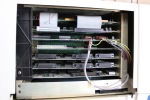
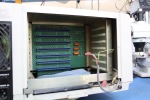
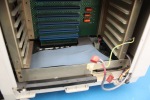
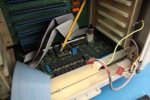
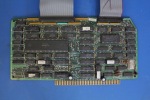
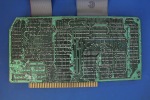
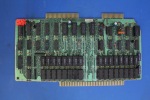
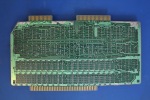
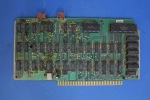
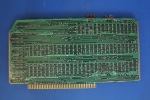
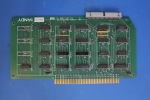
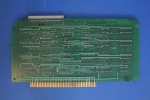
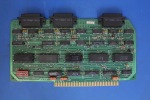
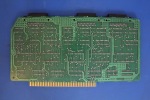
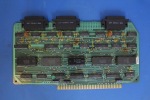
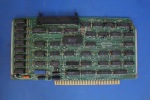
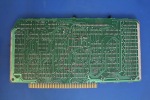
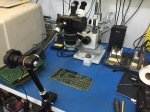
During the 1980’s and into the 1990’s there was an independent computer Wizard named Bob Snapp, located in Cincinnati OH, who was the pre eminant expert on all of the Tandy Computers, especially the ones that ran MS-Xenix (Microsoft port of the Unix operating System). I was Bobs in-house Engineer and did most of the repair and modification to the entire Model 12/16 through Model 6000 machines.
The 68000 CPU board, you show, has the 2 ribbon cables for an early release T6K and would only support 1 memory board. Later releases had 2 memory boards and a different set of cables. The smaller (20 conductor) cable, shown on the left (your photos are upside down) was the Data Buss, and the 34 cond. cable was for the Address lines.
The CPU clock speeds ranged from 4 Mhz to 12 Mhz.
Snappware added another memory chip to the memory boards when Bob discovered that the original design only used 7 of the 8 address lines on the memory chips. The addition was accomplished by piggy backing another memory chip on top of each memory chip on the board. There were also other additions including a 7400 family logic chip, a trace cut and a jumper added accommodate the modification to the addressing. Bob dis-assembled the stock operating system and modified its memory addressing to use the additional memory chips for, what was marketed as ‘Mem Swap’. The access to the hard drive was Not fast, even by 1985 standards but DMA, Direct Memory Access, was much faster. Bob modified the Swap routine to use the memory rather than the hard drive for the Swap process. Swapping happened when the CPU needed to switch from 1 users processing to accommodate another users processing.
The Bernoulli interface card was more accurately referred to as the SCSI Interface. The SCSI board could also interface 9 track Mag Tape drives to the machine.
The Video / KBD interface was the only board that did not have a Buss Address so the board could reside in most any slot in the card cage, but was always placed below the 6000 Memory card(s) and before the 3 User, SCSI I/F, and HD card(s).
We had a need for an 8th slot in the cage, to add more memory boards for the 6000 CPU, and I created a modification to piggy back two 3 User cards to fit in one card slot. We marketed this as the Snapp 6 User Board. We made 100’s of them!
The last card in the cage was the Hard Drive Controller (in the early release machines) and the Hard Drive Interface when Tandy came out with the 6000HD machines. The early T6000 was intended to be a Floppy Disk driven system but Tandy soon realized that this would not be versitile enough to be a true business computer system. They came out with the External Hard Drives (One Primary drive and multiple Secondary drives) with 5 Meg ‘Bubbles’ (The actual hard drive).
Then came the 12 Meg, 15 Meg, and actually made it to 85 Megs by the end of the product cycle. The T600HD had the Primary HD mounted in the bracket where the second Floppy disk drive used to reside. The Floppy drives were 8 inch, Single Sided, Single Density devices that stored about 85K / disk.
The floppy drives were never completely phased out as they were required to initialize the HD during maintenance. It was also used to run the Diagnostics disk, in model 12 mode, (called TRSDOS) to diagnose, and run compliance testing,
for the 6000 CPU/MEM, Floppy drives, and Hard Drives.
The Hard Drive Interface card had a rigid 50 pin cable that connected to the External Primary HD cabinet that had a separate controller board.
The Hard Drive Controller had a 20 pin ribbon cable (data) and a 34 pin Address cable that ran to the internally mounted HD bubble.
The Controller board(s) required periodic maintenance to keep them ‘aligned’. There was a 10 turn variable resistor (pot) that was adjusted to balance a 100mhz pulse and a 2.4 VDC reference signal.
During the many years I worked for Bob, we only ever had one Video/KBD go bad. It was a very robust card.
The SCSI I/F board was also quite robust and did not fail.
Bob also modified the OS with an improved Print Spooler that put the Printer service routine into a background mode so the user was not required to wait for the printer to complete before continuing with their work.
In his previous career as the head programmer for a large grocery chain, Bob made the print spooler mods to the OS of a 1970’s vintage IBM Mainframe to improve through put. IBM claimed LOUDLY that the spooler could not possibly work. Bob proved them wrong.
Bob was also considered a Guru in the Filepro database community. Filepro is Still a viable and vital database management product.
One last item about the Tandy 6000’s; Bob discovered an error message buried in the OS. It was triggered by a Stack Overflow condition, that was theoretically never to happen, and the message was inspired by a Star Trek fan.
The message was “Shut her down Scotty, she’s sucking mud”.
Thanks for all of that cool background information! I love that error message, too.
Not to say that Bob Snapp wasn’t a bright guy – he was and he did some really good and interesting work, but just to set the record somewhat straight, most of the really tough coding that you describe here (such as some of the algorithms for the swap routine mods and the print spooler) was actually mostly written by Greg Pryor as contract work for Bob. Greg and I were his first employees when he had Snappware (we wrote most of the Snapp II through IV product code) and after that shut down he still used Greg for the really tough coding jobs, mostly because Greg was pretty much the best coder anyone any of us had seen – he was the kind of guy who became proficient in Z80 assembler over a weekend because he “thought it looked interesting”.